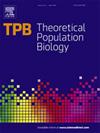赶上浪潮:论行波解在流行病学建模中的适用性。
IF 1.3
4区 生物学
Q4 ECOLOGY
引用次数: 0
摘要
常微分方程模型,如经典的SIR模型,在流行病学中被广泛用于研究和预测传染病动力学。然而,这些模型通常假设种群是均匀混合的,忽略了由于空间异质性导致的疾病患病率的可能变化。为了解决这个问题,反应扩散模型被提出作为一种替代方法来模拟空间连续种群,其中个体以扩散的方式移动。在本研究中,我们探讨了在何种条件下必须明确考虑这种空间结构才能准确预测疾病传播,以及在何种情况下均匀混合假设仍然充分。特别是,我们推导了扩散系数的临界阈值,低于该阈值,疾病传播动态表现出空间异质性。我们通过二维连续景观中基于个体的疾病传播模拟来验证我们的分析结果。利用这一框架,通过将空间结构纳入SI、SIS和SIR模型,我们进一步探讨了疾病建立概率、最大发病率和最终流行规模等关键流行病学参数是如何受到影响的。我们讨论了我们的研究结果对流行病学建模的影响,并确定了疾病动力学空间模拟模型的设计考虑因素和局限性。本文章由计算机程序翻译,如有差异,请以英文原文为准。
Catching a wave: On the suitability of traveling-wave solutions in epidemiological modeling
Ordinary differential equation models such as the classical SIR model are widely used in epidemiology to study and predict infectious disease dynamics. However, these models typically assume that populations are homogeneously mixed, ignoring possible variations in disease prevalence due to spatial heterogeneity. To address this issue, reaction–diffusion models have been proposed as an alternative approach to modeling spatially continuous populations in which individuals move in a diffusive manner. In this study, we explore the conditions under which such spatial structure must be explicitly considered to accurately predict disease spread, and when the assumption of homogeneous mixing remains adequate. In particular, we derive a critical threshold for the diffusion coefficient below which disease transmission dynamics exhibit spatial heterogeneity. We validate our analytical results with individual-based simulations of disease transmission across a two-dimensional continuous landscape. Using this framework, we further explore how key epidemiological parameters such as the probability of disease establishment, its maximum incidence, and its final epidemic size are affected by incorporating spatial structure into SI, SIS, and SIR models. We discuss the implications of our findings for epidemiological modeling and identify design considerations and limitations for spatial simulation models of disease dynamics.
求助全文
通过发布文献求助,成功后即可免费获取论文全文。
去求助
来源期刊

Theoretical Population Biology
生物-进化生物学
CiteScore
2.50
自引率
14.30%
发文量
43
审稿时长
6-12 weeks
期刊介绍:
An interdisciplinary journal, Theoretical Population Biology presents articles on theoretical aspects of the biology of populations, particularly in the areas of demography, ecology, epidemiology, evolution, and genetics. Emphasis is on the development of mathematical theory and models that enhance the understanding of biological phenomena.
Articles highlight the motivation and significance of the work for advancing progress in biology, relying on a substantial mathematical effort to obtain biological insight. The journal also presents empirical results and computational and statistical methods directly impinging on theoretical problems in population biology.
 求助内容:
求助内容: 应助结果提醒方式:
应助结果提醒方式:


